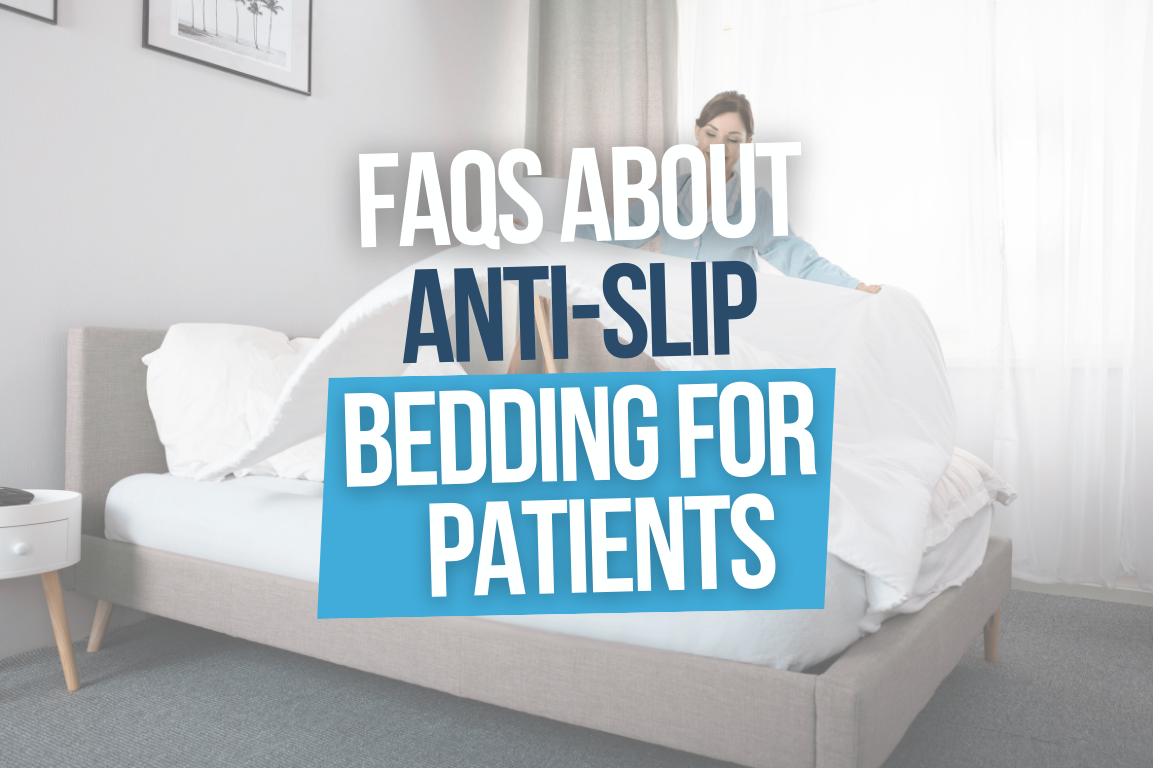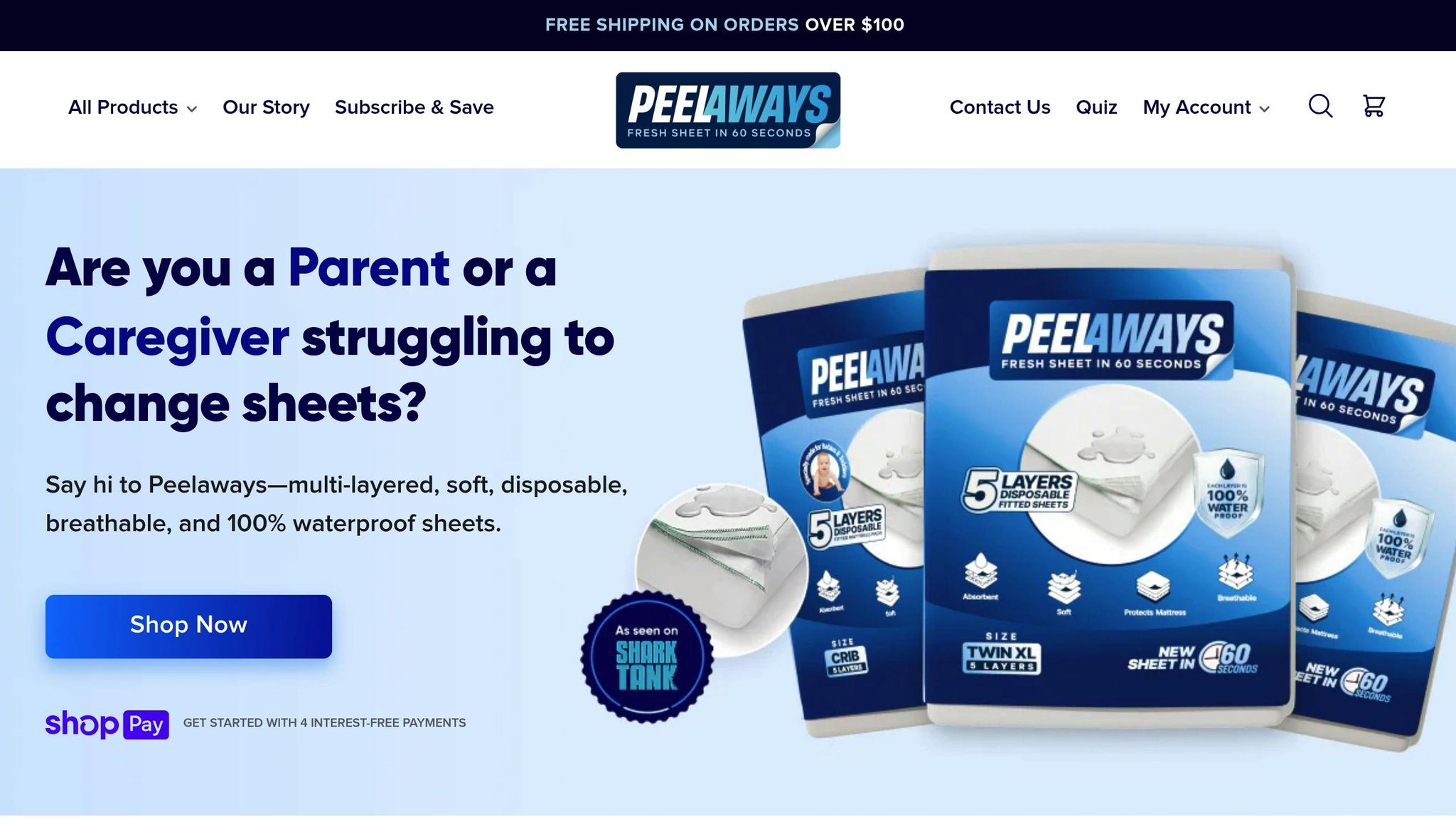FAQs About Anti-Slip Bedding for Patients

Anti-slip bedding is designed to keep mattresses and sheets securely in place, making it safer and more comfortable for patients, especially those with mobility challenges or medical needs. It uses materials like silicone fibers, elastic bands, and anti-friction panels to prevent slipping and ensure stability. Caregivers benefit from reduced strain and easier maintenance, while patients experience improved comfort and dignity.
Key Takeaways:
- Safety: Prevents falls and keeps bedding stable for patients with limited mobility.
- Caregiver Convenience: Reduces time spent adjusting bedding and simplifies cleaning.
- Comfort: Provides a stable, wrinkle-free surface for better rest and recovery.
- Special Features: Includes waterproof layers, multi-layer options (e.g., PeelAways), and secure fasteners.
Anti-slip bedding is particularly helpful for elderly individuals, post-surgical patients, and those managing incontinence. Proper installation, regular cleaning, and adherence to safety guidelines ensure optimal performance and hygiene.
How Anti-Slip Bedding Works
Design and Materials
Anti-slip bedding employs smart design elements and materials to keep sheets and covers firmly in place. One of the most common methods involves specialized fasteners and clips that attach directly to the bedding. These clips, often made from durable plastic and featuring adjustable bow fixators, grip the fabric tightly to prevent shifting [1].
In addition to clips, anti-slip bedding often includes features like high-density fabrics, elastic bands, deep pockets, and zipper enclosures. Together, these components create a snug fit that resists movement.
In medical settings, anti-slip bedding takes functionality a step further by incorporating anti-friction panels. These panels not only help with patient repositioning but also reduce skin shear during transfers. At the same time, they ensure the bedding remains securely anchored to the mattress [4].
These thoughtful design elements address the shortcomings of conventional bedding, offering a more secure and practical solution.
Differences from Standard Bedding
When compared to standard bedding, the advantages of anti-slip designs become obvious.
For starters, fit and functionality are vastly improved. Standard bedding, like twin sheets, often struggles to fit non-standard mattress sizes such as hospital beds. These beds have unique dimensions that standard sheets simply aren’t designed to accommodate.
Another key difference lies in movement prevention. Standard bedding typically relies on basic elastic corners, which can lose their grip over time - especially with smooth materials like silk or satin. In contrast, anti-slip bedding uses advanced grip technologies and secure fastening systems to keep sheets firmly in place [3].
Safety is another area where anti-slip bedding shines. Standard sheets may slip off and create entanglement risks, but anti-slip designs eliminate this concern through features like secure enclosures and adjustable fasteners [2][3].
For caregivers, this stability means less time spent readjusting bedding and more time focused on patient care. It also reduces physical strain, making their work more efficient and less taxing.
Main Benefits of Anti-Slip Bedding
Safety and Fall Prevention
Anti-slip bedding is designed to stay securely in place, even as patients move, which helps reduce the risk of slips and keeps the bed stable. This added security is especially important for individuals with limited mobility, creating a safer environment for both patients and caregivers. While this feature enhances safety, it’s still essential for caregivers and facilities to follow established safety protocols to ensure comprehensive care.
Easier Care for Caregivers
One of the standout advantages of anti-slip bedding is how it simplifies daily care routines. By minimizing the need for constant adjustments, caregivers can spend less time repositioning sheets and more time focusing on patient care. For instance, PeelAways offers a disposable, multi-layer bedding system that allows caregivers to peel away a soiled layer, instantly revealing a clean one underneath. This design not only streamlines bedding changes but also reduces physical strain on caregivers, making their tasks more efficient while maintaining patient comfort.
Better Patient Comfort and Dignity
Secure bedding provides more than just practicality - it enhances the overall care experience for both patients and caregivers. When sheets stay in place, they create a more stable and comfortable sleeping environment, which is essential for quality rest and recovery. Additionally, reducing the need for frequent adjustments helps preserve a patient’s dignity during care routines. For situations requiring waterproof protection, such as managing incontinence, solutions like PeelAways offer a hygienic and convenient option that prioritizes both functionality and patient comfort.
Who Can Benefit from Anti-Slip Bedding
Elderly and Mobility-Limited Individuals
For seniors and those with limited mobility, managing bedding can be a real challenge. Traditional sheets often bunch up or slide around as individuals move, which can compromise both comfort and safety. Anti-slip bedding solves this problem by staying securely in place throughout the night. This reduces the need for constant adjustments - something that can be particularly difficult or even impossible for individuals with mobility restrictions.
Additionally, for elderly individuals who may face incontinence issues or require assistance with personal care, anti-slip bedding with waterproof protection offers a practical solution. This type of bedding ensures a consistent, stable sleep surface, even for those who cannot reposition themselves independently. It not only enhances comfort but also preserves dignity by addressing multiple needs at once.
These benefits are equally important for patients recovering from medical procedures.
Patients with Medical or Recovery Needs
For individuals recovering from surgery, managing chronic illnesses, or dealing with temporary medical conditions, anti-slip bedding can make a significant difference. Post-surgical patients, for example, often have limited mobility and need to avoid unnecessary movements that could interfere with healing. Bedding that stays in place eliminates the hassle of constantly readjusting displaced sheets, allowing patients to focus on resting and recovering.
This type of bedding is especially helpful in situations like orthopedic recovery, cardiac care, or extended periods of bed rest. It’s also a game-changer for those with conditions such as Parkinson's disease, multiple sclerosis, or stroke recovery, where involuntary movements or muscle weakness can cause regular bedding to shift. Anti-slip bedding provides a stable and comfortable foundation, addressing these challenges head-on.
The advantages extend further for individuals dealing with incontinence.
Incontinence and Frequent Bedding Changes
For patients managing incontinence, anti-slip bedding offers a practical and much-needed solution. Standard waterproof mattress protectors often slide out of place, leading to discomfort and wrinkles while failing to provide reliable protection. Anti-slip waterproof bedding, on the other hand, ensures both proper positioning and effective protection.
Caregivers, especially in home care settings, can benefit greatly from products like PeelAways. This multi-layered bedding design combines anti-slip functionality with easy cleanup. When accidents occur, caregivers can simply peel away the soiled top layer to reveal a fresh, clean surface underneath. This eliminates the need for a full bedding change, saving time and effort while keeping the sheets securely in place.
This design is particularly helpful for family caregivers who may lack the physical strength or assistance needed for frequent bedding changes. It reduces the physical strain on caregivers and minimizes disruptions for patients. Healthcare facilities also benefit from this system, as it simplifies infection control, cuts down on laundry costs, and saves staff time.
PeelAways’ multi-layer system offers a quick and efficient way to refresh bedding without the hassle of a full replacement. This is especially useful for patients experiencing frequent accidents or in situations where immediate changes aren’t always feasible, like overnight or during periods when caregivers are unavailable. By combining convenience with functionality, this bedding design provides much-needed relief for both caregivers and patients.
How Prevent Patient From Sliding Down in Hospital Bed Continuously SETTING Position Hill-Rom Stryker

sbb-itb-45288fe
Features to Look for in Anti-Slip Bedding
Selecting the right anti-slip bedding is essential for ensuring both safety and comfort in patient care. Here’s what to consider when evaluating options.
Key Features for Safety and Hygiene
High-quality anti-slip bedding should include a non-slip backing, durable materials, and advanced safety features that go beyond basic requirements. One of the most important aspects is grip technology, which enhances both safety and hygiene. Bedding with a silicone coating or a specialized non-slip backing creates friction with the mattress, effectively preventing sheets from sliding or shifting [5][6].
The material used is just as important. Choose bedding made from durable, skin-friendly fabrics that can handle frequent cleaning and repeated use without losing their effectiveness [6].
In healthcare settings, meeting safety standards is non-negotiable. Look for bedding that complies with flame retardancy tests, such as the BS:7175 flame retardant standard [6].
Waterproofing is another must-have feature. Bedding should provide a moisture barrier to protect the mattress while remaining breathable to avoid heat buildup, which can lead to discomfort or skin issues.
Hygiene is critical, too. Opt for bedding that is easy to clean and sanitize - requiring only a quick wipe with water or a mild detergent for daily upkeep [6][7]. Additionally, designs that simplify caregiver routines can make a big difference in day-to-day use.
Easy-to-Use Features for Caregivers
Caregivers benefit from bedding that’s designed to make their jobs easier. Look for fitted designs that install quickly and stay securely in place without requiring additional adjustments throughout the day.
Compatibility with standard U.S. bed sizes is another key feature. Whether the need is for pediatric cribs, Twin or Twin XL hospital beds, or larger sizes like Full, Queen, or King for home care, the bedding should fit seamlessly with American mattress dimensions.
Noise reduction is also worth considering. Bedding that minimizes rustling sounds helps create a more restful environment for patients [6].
Customizable options can add even more value. Some anti-slip pads or underlays can be trimmed or adjusted to fit different bed types, from standard nursing beds to specialized medical setups [6].
Lastly, low-maintenance designs reduce the workload for caregivers, allowing them to focus more on the patient and less on managing bedding.
Example: PeelAways Multi-Layer Bedding

PeelAways offers an innovative solution that perfectly illustrates these features. Their patented multi-layer peel-away design allows caregivers to quickly remove a soiled layer, revealing a clean and fresh surface underneath.
Depending on the size, PeelAways bedding provides between 5 to 7 layers. For example, Cot and Twin XL sizes include 7 layers, while Twin, Full, Queen, and King sizes typically have 5 layers. For pediatric care, the Crib-A-Peel offers 5 layers specifically tailored to smaller beds.
The materials used are soft, absorbent, and durable, ensuring comfort while maintaining functionality. The fitted design keeps each layer securely in place, even during use.
PeelAways is available in all major U.S. bed sizes, with prices starting at $30.99 for Crib-A-Peel and going up to $53.99 for King. Most options are priced around $34.99. The company also offers free shipping on orders over $100 and a 15% discount for subscription purchases, making it an economical choice for long-term care needs.
One of the standout benefits of PeelAways is its zero cross-contamination design. Since each layer is completely removed after use, there’s no risk of transferring contaminants between changes. This feature, combined with the elimination of traditional laundry requirements, significantly reduces the time and effort needed to maintain cleanliness and infection control in care settings.
Safety and Maintenance Tips
Using anti-slip bedding effectively and safely involves proper setup, regular upkeep, and following key safety practices. These steps help ensure the well-being of patients while maintaining the bedding's performance over time.
Proper Installation and Use
To get the most out of anti-slip bedding, it's crucial to install it correctly. Start by ensuring the bedding is designed to fit snugly on the mattress without wrinkles. For fitted options like PeelAways, double-check that the elastic edges are securely fastened around all four corners.
If you're working with multi-layer bedding systems, make sure each layer is properly aligned to create a smooth, even surface. Take a moment to smooth out any air bubbles or wrinkles, as these can interfere with the anti-slip function.
Store and handle the bedding according to the manufacturer's instructions. Keep in mind that exposure to extreme temperatures can affect the material's grip. For patients who tend to move around a lot during sleep, gently pull at different points of the bedding after installation to confirm it stays secure. Also, avoid placing heavy objects on the bedding, as this could compromise its anti-slip properties.
A good installation process sets the stage for easy maintenance and long-term safety.
Cleaning and Disposal
Inspect the bedding daily for any signs of wear, such as tears, discoloration, or changes in texture. These could indicate that the bedding's effectiveness has diminished and may need replacing.
When washing reusable bedding, always follow the manufacturer's care instructions. Avoid using fabric softeners, as they can reduce the material's grip. For disposable multi-layer systems, promptly remove and dispose of soiled layers according to facility guidelines to reduce contamination risks.
Before putting on a fresh layer of bedding, sanitize the mattress surface using an approved disinfectant. This step minimizes the chance of cross-contamination. Replacement schedules should be based on the condition of the bedding and its actual usage, rather than a fixed timeline.
Safety Standards and Guidelines
In addition to proper installation and cleaning, following safety standards is key to ensuring both patient protection and bedding performance. While anti-slip bedding isn't classified as a medical device, general textile and sanitation guidelines still apply. For example, the Centers for Disease Control and Prevention (CDC) advises that bedding in healthcare settings be laundered in a way that ensures thorough disinfection.
Fire safety is another important consideration. Look for bedding that meets established fire safety standards, such as those outlined in the NFPA Life Safety Code, which address flame resistance and smoke generation.
When bedding is contaminated with bodily fluids, OSHA's bloodborne pathogen standards come into play. Staff should wear appropriate personal protective equipment when handling soiled bedding and follow strict protocols for containment and disposal.
State licensing requirements for nursing homes and assisted living facilities may include additional bedding and hygiene standards. Be sure to consult local health department guidelines to ensure compliance.
For home care settings, adopting similar safety measures - like practicing good hand hygiene, properly disposing of used bedding, and storing clean bedding in a sanitary location - can help protect both patients and caregivers, ensuring a safe and respectful care environment.
Summary and Key Points
Anti-slip bedding plays a key role in reducing falls and promoting safety for patients who have mobility challenges or are in recovery. By keeping patients securely in place during transfers and care routines, it helps create a safer environment for both patients and caregivers.
Key Benefits at a Glance
The standout benefit of anti-slip bedding is its ability to enhance safety by minimizing the risk of falls during patient transfers and adjustments [8]. Beyond safety, it also makes caregiving tasks more manageable, reduces physical strain on caregivers, and supports patient comfort and dignity. These features highlight the importance of selecting bedding that prioritizes both patient safety and caregiver convenience.
Practical Recommendations
To maximize the safety benefits, choose bedding that aligns with your specific care needs. Look for features like secure bed rails, anti-slip mattresses, and user-friendly controls - all designed to lower the risk of falls and injuries [9].
A great example is PeelAways multi-layer bedding, which combines a peel-away design to prevent cross-contamination with a snug, secure fit for added safety.
When making your selection, consider the unique demands of your care setting. Proper installation and routine upkeep are essential for maintaining safety, so ensure caregivers are trained in correct usage and perform regular inspections to keep everything in top condition.
FAQs
How can anti-slip bedding help patients with limited mobility or incontinence?
Anti-slip bedding serves a dual purpose: enhancing safety and providing comfort for patients with limited mobility or those dealing with incontinence. By minimizing the risk of sliding or falling, it offers much-needed stability for individuals who may find it challenging to adjust their position in bed.
For those managing incontinence, this bedding often includes waterproof and absorbent layers. These features help keep the bed dry, safeguard the mattress, and maintain a clean, sanitary environment. This not only simplifies caregiving but also ensures the patient feels more comfortable and at ease.
What should I look for when choosing anti-slip bedding for healthcare use?
When choosing anti-slip bedding for healthcare environments, focus on strong, reliable materials that offer dependable slip resistance. Options like textured fabrics or anti-slip panels can play a key role in improving patient safety and minimizing the chances of falls.
Equally important is selecting bedding that is simple to clean and maintain. Look for options that can withstand hospital-grade disinfectants and dry quickly to uphold hygiene standards and support infection control measures. Bedding designed to streamline care routines while prioritizing both comfort and safety for patients is an ideal choice.
How can caregivers clean and maintain anti-slip bedding to ensure it stays hygienic and safe?
To maintain anti-slip bedding in a hygienic and safe condition, it’s important for caregivers to replace it frequently - ideally once a week or immediately if it becomes soiled. Regular changes help prevent bacteria buildup and lower the chance of infections. Adding waterproof or protective covers can simplify cleaning and reduce the risk of contamination.
Make sure the bedding is always clean, dry, and free of irritants to safeguard the patient’s skin and respiratory well-being. For easier management, disposable multi-layer sheets can be a practical option, allowing for quick changes without the hassle of heavy lifting or laundry.
Related Blog Posts
- Why Organic Waterproof Bedding Matters for Incontinence Care
- How to Choose Bedding for Incontinence Care
- How Disposable Bed Sheets Reduce Caregiver Stress
- How Moisture-Wicking Sheets Help Prevent Bed Sores
Comments
0

SAVE MONEY & WATER
Professionals & Institutions save a fortune on labor/laundry.

SUPERIOR COMFORT
The first thing our customers notice is how soft our sheets are.

100% WATERPROOF
Each layer is 100% Waterproof, perfect for spills and accidents

SAVE TIME
Change the sheet in under 1 minute without stripping the bed.




Leave a comment